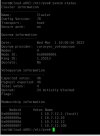Hi all
I read topics about large clusters and did not find a solution for myself. We have one of the clusters with 46 servers, and after about 36 servers, problems with the cluster began with active use (vm migration)
version of all nodes 7.3.3
1- corosync network is separated into a separate vlan/corosync is on the same subnet
2- knet_transport is used: sctp (the cluster feels more stable on it)
is there anything else that can be tweaked to make the cluster feel normal? I do not want to split into several clusters
on the screenshots, its standard behavior at any load
after the end of the unsuccessful migration, the cluster is going back


I read topics about large clusters and did not find a solution for myself. We have one of the clusters with 46 servers, and after about 36 servers, problems with the cluster began with active use (vm migration)
version of all nodes 7.3.3
1- corosync network is separated into a separate vlan/corosync is on the same subnet
2- knet_transport is used: sctp (the cluster feels more stable on it)
Code:
quorum {
provider: corosync_votequorum
}
totem {
cluster_name: Cluster
config_version: 70
interface {
knet_transport: sctp
linknumber: 0
}
ip_version: ipv4-6
knet_ping_interval: 200
knet_ping_timeout: 5000
knet_pong_count: 1
link_mode: passive
secauth: on
version: 2
}is there anything else that can be tweaked to make the cluster feel normal? I do not want to split into several clusters
on the screenshots, its standard behavior at any load
after the end of the unsuccessful migration, the cluster is going back



